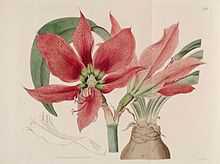Hippeastrum aulicum
| Hippeastrum aulicum | |
|---|---|
 | |
| Scientific classification | |
| Kingdom: | Plantae |
| Clade: | Angiosperms |
| Clade: | Monocots |
| Order: | Asparagales |
| Family: | Amaryllidaceae |
| Subfamily: | Amaryllidoideae |
| Tribe: | Hippeastreae |
| Subtribe: | Hippeastrineae |
| Genus: | Hippeastrum |
| Species: | H. aulicum |
| Binomial name | |
| Hippeastrum aulicum (Ker Gawl.) Herb.[1] | |
Hippeastrum aulicum


Botanical Register 1820, 1826
Hippeastrum aulicum, the Lily of the Palace, is a bulbous perennial, in the Amaryllidaceae family, native to the Atlantic Forest and Cerrado ecoregions from Brazil to Paraguay, in South America.
Description
Hippeastrum aulicum is a bulbous epiphyte, growing on rocks and trees with has large scarlet flowers with a green throat, usually with four flowers to a stem. It blooms in late summer and autumn.[2]
Taxonomy
Hippeastrum aulicum was first described by Ker Gawler in 1883.[1][3]
Synonyms
See The Plant List [4]
- Amaryllis aulica Ker Gawl.
- Amaryllis aulica var. platypetala Lindl.
- Amaryllis heuseriana (H.Karst.) Ravenna
- Amaryllis heuseriana f. campanulata Ravenna
- Amaryllis robusta Otto & A.Dietr. [Illegitimate]
- Amaryllis rougieri Carrière
- Amaryllis tettanii auct.
- Aulica latifolia Raf.
- Aulica platypetala (Lindl.) Raf.
- Aulica striata Raf.
- Hippeastrum aulicum var. platypetalum (Lindl.) Herb.
- Hippeastrum aulicum f. robustum (A.Dietr. ex Walp.) Voss
- Hippeastrum heuserianum H.Karst.
- Hippeastrum robustum A.Dietr. ex Walp.
- Hippeastrum tweedianum Herb.
- Omphalissa aulica (Ker Gawl.) Salisb.
- Trisacarpis rubra Raf.
Etymology
The species name aulicum comes from the Latin, meaning 'princely'.[5]
Cultivation
Hippeastrum aulicum is cultivated by specialty flower bulb nurseries as an ornamental plant.[6]
References
- ↑ 1.0 1.1 Royal Botanic Gardens, Kew: H. aulicum.
- ↑ Pacific Bulb Society: Hippeastrum aulicum
- ↑ "Hippeastrum aulicum". Tropicos. Missouri Botanical Gardens. Retrieved 19 March 2014.
- ↑ Hippeastrum aulicum in The Plant List
- ↑ Griffith, Chuck (2005). "Dictionary of Botanical Epithets". Retrieved 19 March 2014.
- ↑ "For The Love Of Bulbs" Blog: Hippeastrum aulicum . accessed 11.28.2013
Sources
- "List of Species of the Brazilian Flora". Reflora. Rio de Janeiro Botanical Garden. Retrieved 19 March 2014.
- Zuloaga, F. O., O. Morrone, M. J. Belgrano, C. Marticorena & E. Marchesi. (eds.) 2008. Catálogo de las Plantas Vasculares del Cono Sur (Argentina, Sur de Brasil, Chile, Paraguay y Uruguay). Monogr. Syst. Bot. Missouri Bot. Gard. 107(1): i–xcvi, 1–983; 107(2): i–xx, 985–2286; 107(3): i–xxi, 2287–3348.
| Wikimedia Commons has media related to Hippeastrum aulicum. |
| Wikispecies has information related to: Hippeastrum aulicum |